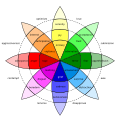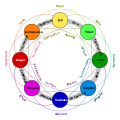History of emotions
 From Wikipedia - Reading time: 9 min
From Wikipedia - Reading time: 9 min
The history of emotions is a field of historical research concerned with human emotion, especially variations among cultures and historical periods in the experience and expression of emotions. Beginning in the 20th century with writers such as Lucien Febvre and Peter Gay, an expanding range of methodological approaches is being applied.
Scope
[edit]In the last decade,[which?] the history of emotions has developed into an increasing productive and intellectually stimulating area of historical research. Although there are precursors of the history of emotions - especially Febvre's Histoire des Sensibilités[1] or Gay's Psychohistory[2] - the field converges methodologically with newer historiographical approaches such as conceptual history, historical constructivism and the history of the body.[3]
Similar to the sociology of emotions or anthropology of emotions, the history of emotions is based on the assumption that not only the expression of feelings, but also the feelings themselves are learned. Culture and history are changing and so are feelings as well as their expression. The social relevance and potency of emotions is historically and culturally variable. In the view of many historians, emotion is, therefore, just as fundamental a category of history, as class, race or gender.
Methodology
[edit]A number of different methodological approaches have been discussed in recent[when?] years. Some historians of the emotions limit their research to the historical analysis of emotional norms and rules under the heading of emotionology.[4] Particularly in the recent past,[when?] however, the methodological spectrum of the history of emotions has expanded to include performative, constructivist and practice theory approaches. Currently fundamental methodological concepts include: emotives,[5] emotional habitus and emotional practice.[6] Additionally there are several terms that describe the different scope and binding effect of feeling cultures such as emotional community,[7] emotional regime,[8] and emotional style.[9] More recently,[when?] the history of emotions has engaged with recent social and cultural turns in the neurosciences, positing the history of emotions as a component part of a broader biocultural historicism.[10]
Bibliography
[edit]Introductions
[edit]- Rob Boddice, The History of Emotions, Manchester: Manchester University Press, 2018.
- Jan Plamper, Geschichte und Gefühl. Grundlagen der Emotionsgeschichte, Munich: Siedler, 2012.
- Barbara Rosenwein and Riccardo Cristiani, What is the History of Emotions? Cambridge: Polity, 2018.
- Richard Firth-Godbehere, A Human History of Emotions, London: 4th Estate, 2022.
Literature
[edit]- Rob Boddice, The History of Emotions: Past, Present, Future, in: Revista de Estudios Sociales, 62 (2017), pp. 10–15.
- Rob Boddice, The History of Emotions, in: New Directions in Social and Cultural History, ed. Sasha Handley, Rohan McWilliam, Lucy Noakes, London: Bloomsbury, 2018.
- Susan J. Matt, Current Emotion Research in History: Or, Doing History from the Inside Out, in: Emotion Review 3, 1 (2011), p. 117–124.
- Bettina Hitzer, Emotionsgeschichte - ein Anfang mit Folgen. Forschungsbericht.[11]
- Anna Wierzbicka, The “History of Emotions” and the Future of Emotion Research, in: Emotion Review 2, 3 (2010), p. 269-273.
- Barbara Rosenwein, Problems and Methods in the History of Emotions.[12]
- William M. Reddy, Historical Research on the Self and Emotions, in : Emotion Review 1, 4 (2009), p. 302-315.
- Florian Weber, Von der klassischen Affektenlehre zur Neurowissenschaft und zurück. Wege der Emotionsforschung in den Geistes- und Sozialwissenschaften, in: Neue Politische Literatur 53 (2008), p. 21-42.
- Daniela Saxer, Mit Gefühl handeln. Ansätze der Emotionsgeschichte.[13]
- Alexandra Przyrembel, Sehnsucht nach Gefühlen. Zur Konjunktur der Emotionen in der Geschichtswissenschaft, in: L’homme 16 (2005), p. 116-124.
- Rüdiger Schnell, Historische Emotionsforschung. Eine mediävistische Standortbestimmung, in: Frühmittelalterliche Studien 38 (2004), p. 173-276.
Methodological discussions
[edit]- AHR Conversation: The Historical Study of Emotions.[14]
- Frank Biess, Discussion Forum „History of Emotions“ (with Alon Confino, Ute Frevert, Uffa Jensen, Lyndal Roper, Daniela Saxer), in: German History 28 (2010), H. 1, p. 67-80.
- Maren Lorenz: Tiefe Wunden. Gewalterfahrung in den Kriegen der Frühen Neuzeit, in: Ulrich Bielefeld/Heinz Bude/Bernd Greiner (Hg.): Gesellschaft - Gewalt – Vertrauen. Jan Philipp Reemtsma zum 60. Geburtstag, Hamburger Edition: Hamburg 2012, S. 332–354.
- Jan Plamper, The History of Emotions: An Interview with William Reddy, Barbara Rosenwein, and Peter Stearns, in: History and Theory 49, no. 2 (2010): 237–265.
Research centres and organizations
[edit]- ACCESS The Amsterdam Centre for Cross-disciplinary Emotion and Sensory Studies[15]
- ARC Centre of Excellence for the History of Emotions (1100-1800)[16]
- Center for the History of Emotions, Max Planck-Institute for Human Development, Berlin[17]
- NACHE The North American Chapter on the History of Emotion[18]
- Queen Mary Centre for the History of Emotions, London[19]
- Les Émotions au Moyen Age (EMMA)[20]
- CHEP: An International Network for the Cultural History of Emotions in Premodernity[21]
- The Emotions Project: The Social and Cultural Construction of Emotions: The Greek Paradigm, Oxford[22]
- Historia cultural del concimiento. Discursos, prácticas, representaciones, Centro de Ciencias humanas y sociales, Madrid[23]
- Cluster of Excellence "Languages of Emotion", FU Berlin[24]
References
[edit]- ^ Lucien Febvre, La sensibilité et l’histoire. Comment reconstituer la vie affective d’autrefois?, in: Annales d’histoire sociale 3 (1941), p. 5-20.
- ^ See Peter Gay’s main work: The Bourgeois Experience. Victoria to Freud, 5 volumes, New York 1984-1998.
- ^ On the precursors of the history of the emotions see: Jan Plamper, Geschichte und Gefühl. Grundlagen der Emotionsgeschichte, München: Siedler 2012, p. 53-72.
- ^ The term emotionology can be traced back to: Peter N. Stearns / Carol Z. Stearns, Emotionology. Clarifying the History of Emotions and Emotional Standards, in: The American Historical Review 90, 4 (1985), p. 813-830 and Rom Harré (ed.), The Social Construction of Emotion, Oxford 1986.
- ^ William M. Reddy, Against Constructionism. The Historical Ethnography of Emotions, in: Current Anthropology 38,3 (1997), p. 327-351.
- ^ See: Monique Scheer, Are Emotions a Kind of Practice (and Is That What Makes Them Have a History)? A Bourdieuan Approach to Understanding Emotion, in: History and Theory 51, no. 2 (May 2012), p. 193-220.
- ^ Barbara H. Rosenwein, Worrying about Emotions in History, in: The American Historical Review 107, 3 (2002), p. 821-845.
- ^ William M. Reddy, The Navigation of Feeling, Cambridge 2001.
- ^ For a discussion on different concepts, see Benno Gammerl, Emotional Styles - Concepts and Challenges, in: Rethinking History 16, 2 (2012), p. 161-175.
- ^ Rob Boddice, The History of Emotions, Manchester: Manchester University Press, 2018.
- ^ "Emotionsgeschicte - ein Anfang mit Folgen" (PDF). Hsozkult.geschite.hu-berlin.de. Archived from the original (PDF) on 31 January 2016. Retrieved 22 February 2015.
- ^ Barbara H. Rosenwein. "Problems and Methods in the history of Emotions" (PDF). Passionsincontext.de. Retrieved 22 February 2015.
- ^ "SEALS - Server für digitalisierte Zeitschriften". retro.seals.ch. Archived from the original on 7 April 2013. Retrieved 2 February 2022.
- ^ Rosenwein, Barbara H.; Reddy, William M.; Plamper, Jan; Livingston, Julie; Lean, Eugenia; Eustace, Nicole (2012). "TAHR Conversions : The Historical Study of Emotions". The American Historical Review. 117 (5): 1487–1531. doi:10.1093/ahr/117.5.1487.
- ^ "ACCESS | Amsterdam Centre for Cross-Disciplinary Emotions and Senses Studies". Access-emotionsandsenses.nl. Retrieved 2015-02-22.
- ^ "Home | ARC Centre of Excellence for the History of Emotion". Historyofemotions.org.au. Archived from the original on 2012-09-20. Retrieved 2015-02-22.
- ^ "History of Emotions | Max Planck Institute for Human Development". Mpib-berlin.mpg.de. Archived from the original on 2015-05-05. Retrieved 2015-02-22.
- ^ "The North American Chapter on the History of Emotion". nachemotion.com. Retrieved 2018-10-01.
- ^ "The Centre for the History of the Emotions, Queen Mary, University of London". Qmul.ac.uk. Retrieved 2015-02-22.
- ^ "Les émotions au Moyen Âge, carnet d'EMMA". Emma.hypotheses.org. Retrieved 2015-02-22.
- ^ "CHEP : An International Network for the Cultural History of Emotions in Premodernity". Archived from the original on November 5, 2012. Retrieved June 4, 2015.
- ^ "Welcome - School of Archaeology - University of Oxford". Emotions.classics.ox.ac.uk. Archived from the original on 2015-02-22. Retrieved 2015-02-22.
- ^ "Historia cultural del conocimiento. Discursos, prácticas, representaciones | Centro de Ciencias Humanas y Sociales". Cchs.csic.es. Archived from the original on 2010-06-07. Retrieved 2015-02-22.
- ^ "Languages of Emotion: Startseite". Languages-of-emotion.de. 2011-05-28. Retrieved 2015-02-22.
External links
[edit]- History of Emotions Blog, Queen Mary Centre for the History of Emotions
- CHE Histories of Emotions Blog[usurped], ARC Centre of Excellence for the History of Emotions (Europe 1100-1800)
- Sociology of Emotions
- History of Emotions data base run by the ARC Centre of Excellence for the History of Emotions (Europe 1100-1800)
- "History of Emotions - Insights into Research" website with short articles on methods of the History of Emotions, run by the Center for the History of Emotions, Max Planck Institute for Human Development, Berlin (Germany)
 KSF
KSF
